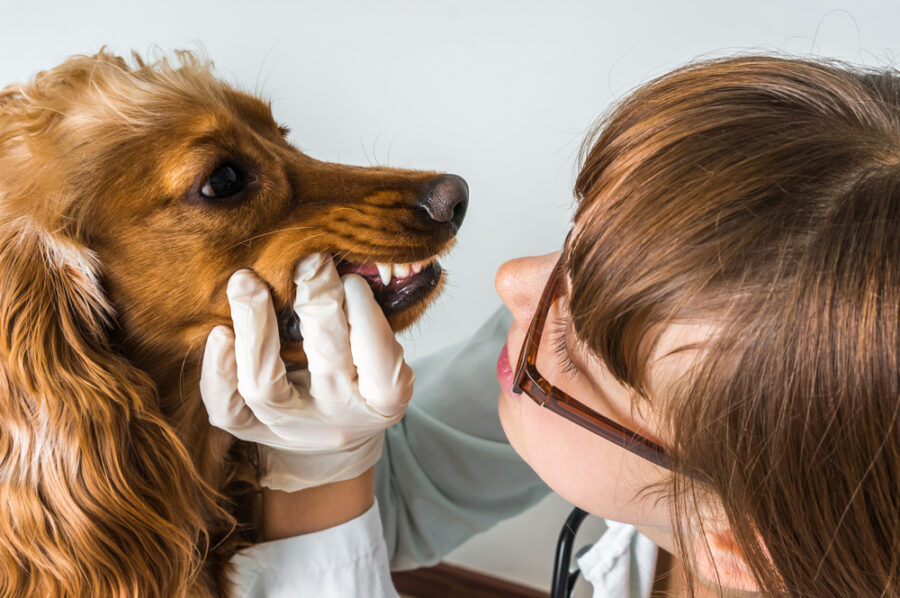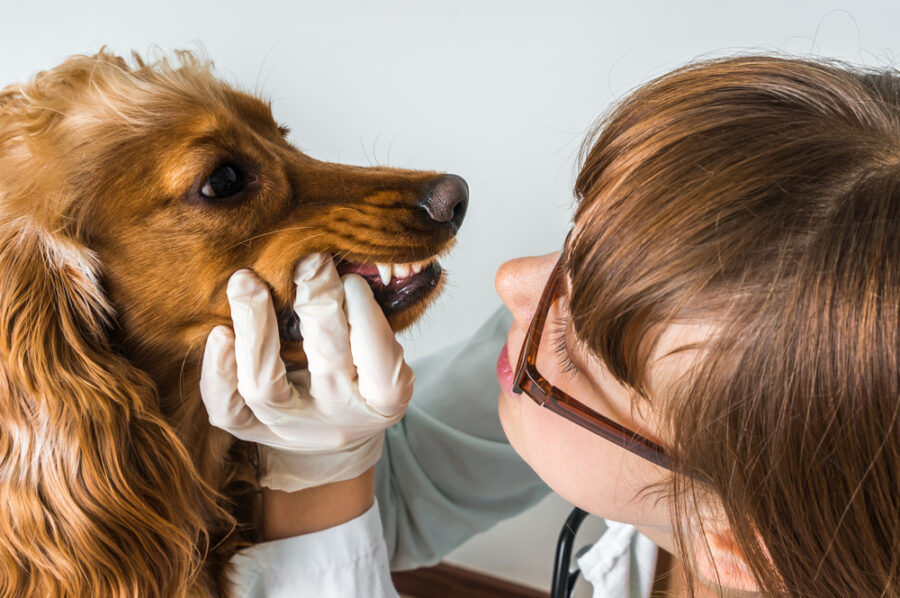
From periodontal disease to crowded teeth, there are various reasons why your dog or cat may need one or more teeth extracted. Find out what they are, and what the procedure entails.
Periodontal disease is a very common problem, affecting approximately 70% to 80% of dogs and cats starting at one to three years of age. Neglecting or improperly treating the issue can lead to further disease and more involved treatment, including dental extractions. But periodontal disease isn’t the only problem that can necessitate extraction. Find out why your dog or cat might need one or more teeth extracted, and how it’s done.
SIMPLE OR COMPLICATED?
When I think of extractions, I divide them into two categories:
- Simple extractions are commonly done in general veterinary practice.
- Complicated extractions are typically referred to a veterinary dentist with advanced training and the proper equipment to deal with these cases.
Simple extractions in my own practice fall into two sub-categories:
- Removing retained deciduous (baby) teeth
- Removing severely diseased adult teeth.
RETAINED DECIDUOUS TEETH
Puppies, particularly those of smaller breeds, often have retained deciduous teeth, most commonly the canines (fangs) and incisors (front teeth). These are generally easy to extract by any veterinarian.
If retained deciduous teeth are not extracted, they crowd the mouth, cause abnormal dentition, and hold in tartar and infection, resulting in the need for more frequent dental care. Retained deciduous teeth can also occur in kittens, although I have never seen this myself.
SEVERELY DISEASED ADULT TEETH
These are also fairly simple to remove, and again occur most often in smaller dog breeds. Severely diseased teeth result from a lack of proper home and professional care, and occur when dental tartar eats away at the gum and periodontal ligament holding the tooth in its sockets. Over time (in some small dogs it can be a matter of months), the tooth becomes loose and requires extraction.
Definitely worth noting: Deciduous teeth should be removed by six months of age, which is when they should have fallen out on their own and been replaced by adult teeth.
Also: Since the root is severely diseased by this time, extraction is quite easy as the tooth is often literally falling out of the patient’s mouth.
I usually don’t find a lot of loose teeth in cats. Instead, cats typically have lesions under the gums that are identified during a periodontal cleaning using dental radiographs. These teeth have severely diseased roots (or in many cases no roots, due to severe disease and destruction), which necessitates extraction. Sometimes during a dental cleaning, root exposure or a cavity is detected. These teeth require further examination and dental radiographs and will typically need to be extracted.
EXTRACTION OR ROOT CANAL?
Root canals preserve the function of the tooth. They involve little to no discomfort to your animal and are less traumatic than extraction, which involves incising soft tissue and the removal of bone. Because a root canal is less invasive, it allows the animal to eat his normal diet the next day and retains the contour of the upper and lower jaws (maxilla and mandible).
Extracting a tooth can be more invasive and traumatic. The roots of back teeth, the premolars, and molars, contain more than one root. These multi-rooted teeth extend deep into the jawbone, and extracting them will remove their chewing function and result in bone loss that can weaken the jaw. The good news is that most dogs and cats will do fine after extraction, which is certainly preferable to the chronic infection, pain, and inflammation that occurs if diseased teeth are not treated or removed.
Also worth noting: The root of a canine tooth is larger than the actual crown and requires more effort to remove than other teeth.
A follow-up visit for an extraction should take place two weeks after the procedure to make sure the incision sites are healing properly. The dog or cat will be placed on a softened diet until the recheck exam, after which he can most likely return to his previous diet.
THE NEED FOR ANALGESIA
Analgesia, or pain prevention and relief, is critical for allowing the dog or cat to be properly treated with little or no discomfort.
Most doctors, including myself, control dental pain using the following method:
- Ideally, injectable medications are first given under the animal’s skin prior to the extraction.
- A regional or local nerve block is used to anesthetize part of the jaw and the associated gums and tooth roots. In human patients, it’s very easy to tell if the nerve is properly blocked. However, we can’t ask a dog or cat if he still feels pain after a block, so we have to rely on our skill at injecting the anesthetic into the area of the nerve (if we miss, we still have the pain relief medication given prior to and following the procedure). I will also usually instill a drop or two of local anesthesia into the empty tooth socket following the extraction.
- After the procedure, you’ll take medications home (a NSAID, opioid, or similar) to administer to your dog or cat for several days following the extractions.
Teeth that are very loose and barely still stuck in the socket will likely result in no pain upon extraction because they require little effort to extract and cause minimal tissue trauma (in some cases, in fact, the extraction might make the animal feel more comfortable). Teeth with diseased roots or that have sustained crown fractures are more likely to cause pain following extraction as they are typically firmly lodged in the socket and will require more effort to remove, resulting in more postoperative discomfort if analgesia is not used.
Also worth noting: The degree of pain involved in any extraction depends on the degree of periodontal disease and the “looseness” of the tooth at the time of extraction.
It’s important to note that many patients require numerous teeth extracted due to advanced disease. While animal parents are often dismayed by the removal/loss of so many teeth, these extractions actually cure the animal, reduce inflammation and infection, and reduce the pain of periodontal disease.
What makes tooth extraction necessary?
- Mobile (loose) teeth — caused by advanced periodontal disease and bone loss
- Crowded teeth
- Retained deciduous teeth
- Teeth that interfere with occlusion — the proper “fit” with the teeth on the opposite jaw
- Teeth in the line of a fracture in the mandible or maxilla
- Teeth destroyed by periodontal disease or damaged by advanced cavities
- Teeth that are endodontically diseased, such as those containing damaged/contaminated pulp, particularly when the animal parent chooses not to treat with a root canal.
What complications can occur with tooth extraction?
While rare, complications can occur and include the following:
- Hemorrhage — may occur several hours post-op if the blood clot retracts or is lost by tongue probing
- Oral-nasal fistulas — normally noticed pre-op, may take several weeks to become apparent following the removal of an upper canine tooth
- Gum flap dehiscence — failure of the sutured gums to heal properly
- Root fracture
- Jaw fracture — more likely in toy or miniature breeds, especially older dogs with severe disease
- Damage to deep structures of the jaw — nerves, blood vessels, etc.
Setting aside any structural abnormalities in your dog or cat’s mouth, regular professional and at-home dental care will go a long way in preventing the need for extractions. Work with your veterinarian to establish the right dental care regimen for your own companion.
Source Link: Pet Lovers Diary
